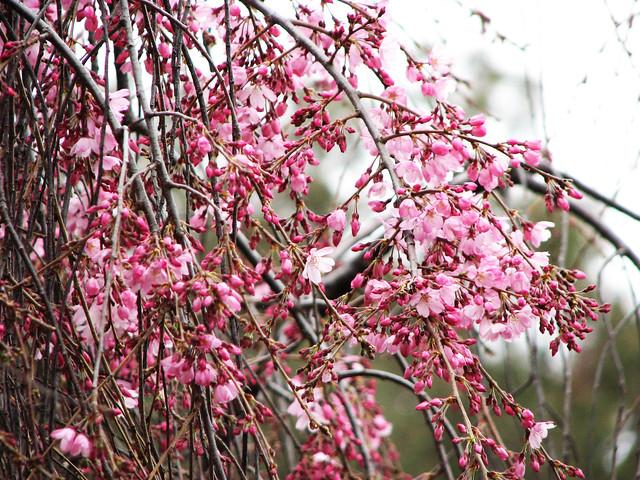This is the first half of a two part series on weeping cherry. The following examines the tree’s distribution and habitat, developmental traits, longevity, height, bark, leaves, flowers, fruit, pruning, root development, and soil and topography.
Introduction
Weeping cherry (Prunus pendula, Prunus subthirtella, or Prunus subhirtella var. pendula), also referred to as the Higan cherry, spring cherry, rosebud cherry, and winter-flowering cherry, is a small ornamental tree that is is native to Japan. It has a broad, weeping habit, and produces an abundance of of showy white to pink flowers in spring. These characteristics have made weeping cherry a popular selection for planting in landscape and garden settings.
Distribution & Habitat
Weeping cherry has a wide distribution. It is indigenous to Japan, where it is prevalent. It has become widespread throughout numerous other countries located in the temperate zone of the Northern Hemisphere. This includes sections of North and South America, Europe, and Asia.
Developmental Traits
Weeping cherry has an upright to spreading growth habit, with a rounded to weeping shape. It grows at a slow to moderate rate. The tree develops thin, slender branches that become firm and flexible over time. Once established, weeping cherry is generally more resistant to extreme temperatures than other cherry trees.
Longevity
Weeping cherry has a short life-span, generally living for 30 to 40 years. With the proper maintenance and care, some varieties can live longer.
Height
Most varieties of weeping cherry will grow 20 to 25 feet in height, with a 15 to 20 foot spread. Some cultivars, such as the double weeping flowering cherry, are dwarf varieties, and will only reach 10 feet tall and 12 feet wide.
Bark
The bark of weeping cherry is shiny, with a copper coloration. As the tree matures, bumps, ridges, or patches may form in the bark surface. When weeping cherry has shed its leaves in fall, the bark becomes more visible. The coppery hue of the bark is appealing, and allows weeping cherry to preserve its aesthetic quality into winter.
Leaves
Weeping cherry leaves are flat and thin, with an ovate shape, serrated edges, and a simple form. The leaves are dark green until fall, when they turn shades of red and orange.
Flowers
In spring, weeping cherry forms clusters of small white to pink flowers, often prior to budburst. The clusters are generally comprised of 3 to 5 flowers. During years when budburst occurs in early spring, the leaves and flowers may appear concurrently. In full bloom, the flowers combine to provide a striking display.
Fruit
In summer, tiny, red to black fruit develop on the branches of weeping cherry. The fruit can grow up to 1/3 of an inch in diameter. The fruit has a sour taste, and is not considered edible for human consumption. Birds favor the fruit, and can often be observed feasting on them when they are present. During some years, weeping cherries may produce little to no fruit.
Pruning
Weeping cherry can be pruned from late fall to winter. To do so, remove any sprouts that form at the base of the tree, as well as any dead or diseased plant material that may be present. To preserve the tree’s natural branch architecture, avoid raising the canopy too high. If any branches are encroaching upon one another, select one to become the dominant branch, and remove the other
Root Development
Weeping cherry requires six to eight hours of direct, unfiltered sunlight each day to thrive. It can also tolerate partial shade. However, it will likely produce fewer blooms, and develop at a slower rate.
Soil and Topography
Weeping cherry is not drought tolerant. As such, it prefers being planted in well-drained soil. The soil surface should be kept moist. A layer of organic mulch can be applied over the top of the soil to preserve the soil moisture, and insulate the roots. When planted in a clay mixture, the soil should be amended with an organic material, such as compost or peat.
Photo courtesy of Corrie Barklimore CC-by-2.0


